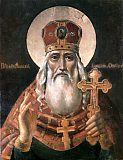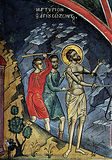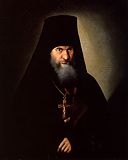

| Previous day | Next day |
| Old Style
September 7
|
Wednesday |
New Style
September 20
|
|
16th Week after Pentecost.
Tone 6.
Fast Day. |
Wine and oil allowed.
|
![]() Forefeast of the Nativity of the Theotokos.
Forefeast of the Nativity of the Theotokos. ![]() Martyr Sozon of Cilicia (304).
Martyr Sozon of Cilicia (304). ![]() St. John, archbishop and wonderworker, of Novgorod (1186).
St. John, archbishop and wonderworker, of Novgorod (1186). ![]() Hieromartyr Macarius of Kanev, archimandrite, of Obruch and Pinsk (1678). St. Macarius, elder, of Optina Monastery (1860).
Hieromartyr Macarius of Kanev, archimandrite, of Obruch and Pinsk (1678). St. Macarius, elder, of Optina Monastery (1860).
Apostles Evodus (Euodias) (66) and Onesiphorus (67), of the Seventy. Martyr Eupsychius of Caesarea in Cappadocia (ca. 130). St. Luke and St. Peter the Cappadocian, abbots, of the monastery of the Deep Stream (10th c.). Sts. Alexander (Peresvet) and Andrew (Oslyabya), disciples of St. Sergius of Radonezh, who fought at the Battle of Kulikovo (1380). St. Serapion of Spaso-Eleazar Monastery, Pskov (1480)
New Hieromartyrs Eugene (Zernov), metropolitan of Nizhni- Novgorod, Leo (Yegorov), archimandrite, of the St. Alexander Nevsky Lavra, Nicholas (Ashchepev), abbot, of the Holy Trinity Selinginsk Monastery, Eugene (Vyzhva), abbot, of Zhitomir (Ukraine), Pachomius (Ionov), hieromonk of the Holy Trinity Skanov Monastery (Penza), and Stephen (Kreidich), priest, of Robchik (Bryansk) (1937). New Hieromartyr John Maslovsky, priest, of Verkhne-Poltavka, Amur (1921).
Sts. Symeon (1476) and Amphilochius (1570), of Pangarati Monastery (Romania). St. Cloud (Clodoald), founder of Nogent-sur-Seine Monastery, near Paris (560). St. Cassia (Cassiana) the Hymnographer (9th c.).
Repose of Metropolitan Isidore (Nikolsky) of St. Petersburg (1892) and Archbishop Anatole (Kamensky) of Irkutsk (1925).
Thoughts for Each Day of the Year
According to the Daily Church Readings from the Word of God
By St. Theophan the Recluse

Wednesday. [Gal. 6:2-10; Mark 7:14-24]
From within, out of the heart of men, proceed evil thoughts, adulteries, fornications, murders, thefts, covetousness, wickedness, deceit, lasciviousness, an evil eye, blasphemy, pride, foolishness. Here common sins are listed; but all the rest also, both large and small, proceed from the heart, and the form in which they proceed are evil thoughts. The first seed of evil falls as a thought to do this or that. Why and how does it occur? Part of these occurrences can be explained by known laws of the combining and linking of ideas and images, but only part. Another, most significant part comes from the self-propelled irritation of the passions. When a passion lives in the heart, it cannot not demand satisfaction. This demand is revealed in an urge for something or other; with the urge is united with some or other object. From here comes the thought: “That is what I must do.” Here the same thing happens as, for example, when one is hungry: feeling hunger, one feels an urge for food; with the urge comes the thought of the food itself; from this follows obtaining this or eating that. Third, perhaps a bulkier part, proceeds from unclean powers. The air is filled with them, they dart around people in packs, and each according to its kind spreads its influence around itself onto people with whom it comes into contact. Evil flies from them like sparks from a red-hot iron. Where it is readily accepted the spark takes root, and with it the thought about an evil deed. Only by this can one explain why evil thoughts arise for unknown reasons, in the midst of activities which decisively are not related to them. But this variety of reasons does not make for variety in terms of how to react to evil thoughts. There is one law: an evil thought has come—cast it out and the matter is finished. If you do not cast it out the first minute, it will be harder the second minute, and the third minute yet harder; and then you will not even notice how sympathy, desire, and the decision will be born; then the means will appear … and sin is at hand. The first opposition to evil thoughts is soberness, and vigilance with prayer.
Thursday. [Eph. 1:1-9; Mark 7:24-30]
What moved the Syrophenician woman to come to the Lord and be so persistent in her petition? The shape of her convictions which had formed—she was convinced that the Saviour had power to heal her daughter and she came to Him; she was convinced that He would not leave her petition without fulfilment, and she would not stop asking. Convictions are the sum total of all of life, upbringing, current thinking, impressions from surroundings, from teachings received and various incidents and activities in life. One’s thoughts work under the influence of all this, and come to certain convictions. Meanwhile one must keep in mind that God’s truth is everywhere, and from everywhere crowds into the soul of man. Truth lies in the heart of man; God’s truth is imprinted in all creatures. There is God’s truth in the customs and dispositions of man; it is also in his teachings to a greater or lesser degree. But falsehood is everywhere as well. He who is of the truth gathers the truth, and is full of true, saving convictions. Whereas he who is not of the truth gathers lies and is full of false convictions, and fatal delusions. Whether a person is of the truth or not of the truth—let everyone examine for himself; but meanwhile God’s judgment awaits everyone.…
Articles
 Martyr Macarius the Archimandrite of Kanev and PereyaslavlThe Hieromartyr Macarius of Kanev lived in the seventeenth century. This was a most terrible time for Orthodox Christians in western Rus. |
 Apostle Evodius (Euodias) of the SeventyThe Holy Apostle Evodius of the Seventy was, after the holy Apostle Peter, the first bishop in Syrian Antioch. |
 Apostle Onesiphorus of the SeventySaint Onesiphorus was bishop at Colophon (Asia Minor), and later at Corinth. |










